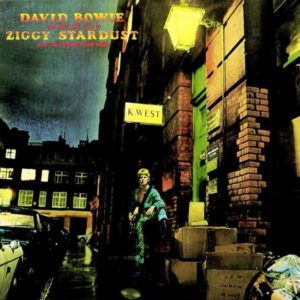- in Isolated Track , Production , Video by Bobby Owsinski
David Bowie “Ziggy Stardust” Isolated Vocal
 Here’s a real treat. It’s the isolated vocal track from the title track of David Bowie’s iconic Ziggy Stardust album and it features not only David’s excellent vocal skills, but producer/engineer’s Ken Scott’s impeccable production as well. For those of you who don’t know or don’t remember, I co-wrote Ken’s autobiography Abbey Road To Ziggy Stardust and there were so many great Bowie stories that he related while doing it that it’s difficult to pick just one, so I’ll include a few.
Here’s a real treat. It’s the isolated vocal track from the title track of David Bowie’s iconic Ziggy Stardust album and it features not only David’s excellent vocal skills, but producer/engineer’s Ken Scott’s impeccable production as well. For those of you who don’t know or don’t remember, I co-wrote Ken’s autobiography Abbey Road To Ziggy Stardust and there were so many great Bowie stories that he related while doing it that it’s difficult to pick just one, so I’ll include a few.
Since this is all about the isolated vocal, a great story from the book is about David doing vocals. According to Ken:
“David was always exceptional with his vocals, since 99% of the time it was the first take, beginning to end, with no punches. I’d get the level and he’d sing the song down and that would be it. Sure made my job easy. You’d think there was a mistake when he was laying it down, but when we’d listen to the playback we’d find that what we thought sounded odd the first time through was intentional and worked perfectly.”
OK, how about the technical bits of recording Bowie. Again from the book:
“What I quite often did while recording David’s vocals was use an AKG C12a and a U67 and place them at a 90 degree angle to each other so he was singing in-between them. I came up with this method so I could instantly switch between the two to see which mic sounded better (and maybe even use both), instead of having him stand in front of one mic and sing a bit, then go in front of the other mic and sing a bit. It also had the added benefit of helping suppress any popping and sibilance as well. We didn’t have many tracks at that time, so even if both mics were used, they were mixed together to a single track. Unlike many other recordings of the time, we never recorded the effects because David only did one take, so there was never any time to set them up.”
How about mixing? Again, right from the source:
“The album, like the others that followed, was mixed on a 20 input Sound Techniques console, using moderate board EQ, a single EMT plate reverb, and just a little compression on the overall mix. Compression came from two UREI 1176’s and two Teletronix LA2A’s. The multitrack machines were an Ampex 8 track and later a 3M 16 track. Any delay came from a Studer C37 stereo tape machine with a varispeed.”
Just a little bit about Ziggy Stardust the album, which everyone mistakenly mistook for a concept album. According to Ken:
“There’s always been this whole thing about Ziggy being a concept album, but it really wasn’t. There are only two rock albums that I would 100% consider concept albums; Tommy and Quadrophenia by The Who, and that’s because they were written as a complete piece, whereas Ziggy was just a patchwork of songs. Yes, they fit together very well and one can weave a story from some of them, but when you consider that “Round and Round” was originally there in place of “Starman,” it doesn’t make much sense as a concept. How does “Round and Round” ever fit into the Ziggy story? It’s a classic Chuck Berry song. How does “It Ain’t Easy” fit in with the Ziggy concept? That was taken from the Hunky Dory sessions. All this about Ziggy being Starman is bullshit. It was a song that was just put in as a single at the last minute at the record label’s insistence. So while it’s true that there were a few songs that fitted the ”concept”, the rest were just songs that all worked well together as they would in any good album.”
With those things in mind, here are some things to listen for:
1. Listen to how much reverb is on the vocal during the verse, then how dry it is in the chorus.
2. Listen closely for when the vocal is doubled, and when it sits by itself.
It’s so cool to be able to go back and listen to this again with a bit more of an x-ray on the vocal. Bowie was a exceptional once-in-a-lifetime artist and this is just one of many, many examples of that.

